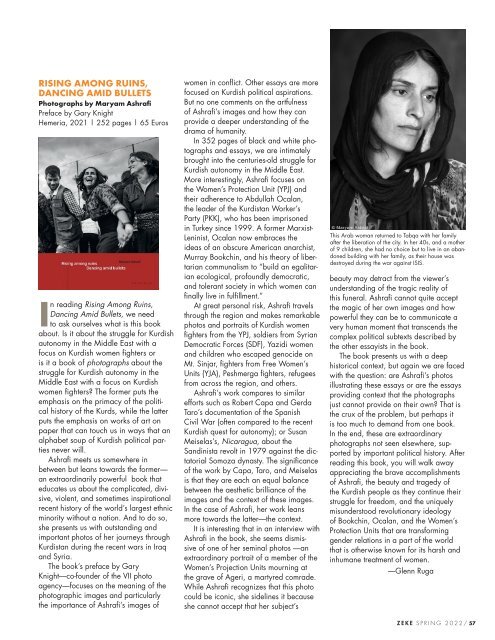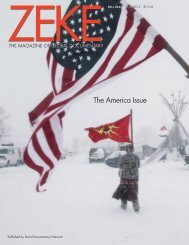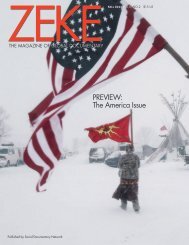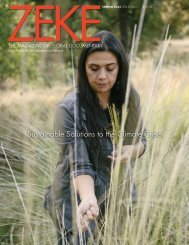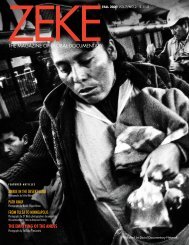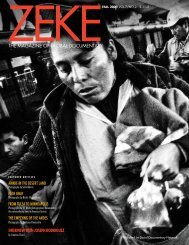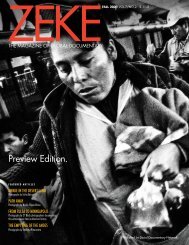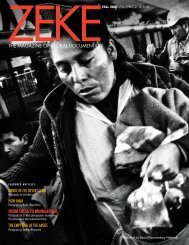ZEKE Magazine: Spring 2022
Sustainable Solutions to the Climate Crisis Indigenous Fire by Kiliii Yuyan The Indigenous Peoples' Burn Network is training others in an ancient technique of ecological restoration, which is to safely light low-intensity fires in wet seasons that remove the small fuels on the forest floor. Nemo's Garden by Giacomo d'Orlando Nemo’s Garden—the world’s first underwater greenhouses of terrestrial plants—represents an alternative farming system dedicated to those areas where environmental conditions make the growth of plants almost impossible. Permagarden Refugees by Sarah Fretwell The Palabek refugee settlement in Northern Uganda, with the staff of African Women Rising’s (AWR) Permagarden Program, works with refugees to utilize the existing resources—seeds, rainfall, limited land, and “waste”—and together build an agriculture system designed to help the environment regenerate and get stronger as it matures. Sustainable Solutions to the Climate Crisis by Antonia Juhasz Interview with Kiliii Yuyan by Caterina Clerici Dispatches from Ukraine by Maranie Staab Book Reviews Edited by Michelle Bogre
Sustainable Solutions to the Climate Crisis
Indigenous Fire by Kiliii Yuyan
The Indigenous Peoples' Burn Network is training others in an ancient technique of ecological restoration, which is to safely light low-intensity fires in wet seasons that remove the small fuels on the forest floor.
Nemo's Garden by Giacomo d'Orlando
Nemo’s Garden—the world’s first underwater greenhouses of terrestrial plants—represents an alternative farming system dedicated to those areas where environmental conditions make the growth of plants almost impossible.
Permagarden Refugees
by Sarah Fretwell
The Palabek refugee settlement in Northern Uganda, with the staff of African Women Rising’s (AWR) Permagarden Program, works with refugees to utilize the existing resources—seeds, rainfall, limited land, and “waste”—and together build an agriculture system designed to help the environment regenerate and get stronger as it matures.
Sustainable Solutions to the Climate Crisis
by Antonia Juhasz
Interview with Kiliii Yuyan by Caterina Clerici
Dispatches from Ukraine by Maranie Staab
Book Reviews Edited by Michelle Bogre
Create successful ePaper yourself
Turn your PDF publications into a flip-book with our unique Google optimized e-Paper software.
RISING AMONG RUINS,<br />
DANCING AMID BULLETS<br />
Photographs by Maryam Ashrafi<br />
Preface by Gary Knight<br />
Hemeria, 2021 | 252 pages | 65 Euros<br />
In reading Rising Among Ruins,<br />
Dancing Amid Bullets, we need<br />
to ask ourselves what is this book<br />
about. Is it about the struggle for Kurdish<br />
autonomy in the Middle East with a<br />
focus on Kurdish women fighters or<br />
is it a book of photographs about the<br />
struggle for Kurdish autonomy in the<br />
Middle East with a focus on Kurdish<br />
women fighters? The former puts the<br />
emphasis on the primacy of the political<br />
history of the Kurds, while the latter<br />
puts the emphasis on works of art on<br />
paper that can touch us in ways that an<br />
alphabet soup of Kurdish political parties<br />
never will.<br />
Ashrafi meets us somewhere in<br />
between but leans towards the former—<br />
an extraordinarily powerful book that<br />
educates us about the complicated, divisive,<br />
violent, and sometimes inspirational<br />
recent history of the world’s largest ethnic<br />
minority without a nation. And to do so,<br />
she presents us with outstanding and<br />
important photos of her journeys through<br />
Kurdistan during the recent wars in Iraq<br />
and Syria.<br />
The book’s preface by Gary<br />
Knight—co-founder of the VII photo<br />
agency—focuses on the meaning of the<br />
photographic images and particularly<br />
the importance of Ashrafi’s images of<br />
women in conflict. Other essays are more<br />
focused on Kurdish political aspirations.<br />
But no one comments on the artfulness<br />
of Ashrafi’s images and how they can<br />
provide a deeper understanding of the<br />
drama of humanity.<br />
In 352 pages of black and white photographs<br />
and essays, we are intimately<br />
brought into the centuries-old struggle for<br />
Kurdish autonomy in the Middle East.<br />
More interestingly, Ashrafi focuses on<br />
the Women’s Protection Unit (YPJ) and<br />
their adherence to Abdullah Ocalan,<br />
the leader of the Kurdistan Worker’s<br />
Party (PKK), who has been imprisoned<br />
in Turkey since 1999. A former Marxist-<br />
Leninist, Ocalan now embraces the<br />
ideas of an obscure American anarchist,<br />
Murray Bookchin, and his theory of libertarian<br />
communalism to “build an egalitarian<br />
ecological, profoundly democratic,<br />
and tolerant society in which women can<br />
finally live in fulfillment.”<br />
At great personal risk, Ashrafi travels<br />
through the region and makes remarkable<br />
photos and portraits of Kurdish women<br />
fighters from the YPJ, soldiers from Syrian<br />
Democratic Forces (SDF), Yazidi women<br />
and children who escaped genocide on<br />
Mt. Sinjar, fighters from Free Women’s<br />
Units (YJA), Peshmerga fighters, refugees<br />
from across the region, and others.<br />
Ashrafi’s work compares to similar<br />
efforts such as Robert Capa and Gerda<br />
Taro’s documentation of the Spanish<br />
Civil War (often compared to the recent<br />
Kurdish quest for autonomy); or Susan<br />
Meiselas’s, Nicaragua, about the<br />
Sandinista revolt in 1979 against the dictatorial<br />
Somoza dynasty. The significance<br />
of the work by Capa, Taro, and Meiselas<br />
is that they are each an equal balance<br />
between the aesthetic brilliance of the<br />
images and the context of these images.<br />
In the case of Ashrafi, her work leans<br />
more towards the latter—the context.<br />
It is interesting that in an interview with<br />
Ashrafi in the book, she seems dismissive<br />
of one of her seminal photos —an<br />
extraordinary portrait of a member of the<br />
Women’s Projection Units mourning at<br />
the grave of Ageri, a martyred comrade.<br />
While Ashrafi recognizes that this photo<br />
could be iconic, she sidelines it because<br />
she cannot accept that her subject’s<br />
This Arab woman returned to Tabqa with her family<br />
after the liberation of the city. In her 40s, and a mother<br />
of 9 children, she had no choice but to live in an abandoned<br />
building with her family, as their house was<br />
destroyed during the war against ISIS.<br />
beauty may detract from the viewer’s<br />
understanding of the tragic reality of<br />
this funeral. Ashrafi cannot quite accept<br />
the magic of her own images and how<br />
powerful they can be to communicate a<br />
very human moment that transcends the<br />
complex political subtexts described by<br />
the other essayists in the book.<br />
The book presents us with a deep<br />
historical context, but again we are faced<br />
with the question: are Ashrafi’s photos<br />
illustrating these essays or are the essays<br />
providing context that the photographs<br />
just cannot provide on their own? That is<br />
the crux of the problem, but perhaps it<br />
is too much to demand from one book.<br />
In the end, these are extraordinary<br />
photographs not seen elsewhere, supported<br />
by important political history. After<br />
reading this book, you will walk away<br />
appreciating the brave accomplishments<br />
of Ashrafi, the beauty and tragedy of<br />
the Kurdish people as they continue their<br />
struggle for freedom, and the uniquely<br />
misunderstood revolutionary ideology<br />
of Bookchin, Ocalan, and the Women’s<br />
Protection Units that are transforming<br />
gender relations in a part of the world<br />
that is otherwise known for its harsh and<br />
inhumane treatment of women.<br />
—Glenn Ruga<br />
<strong>ZEKE</strong> SPRING <strong>2022</strong>/ 57


